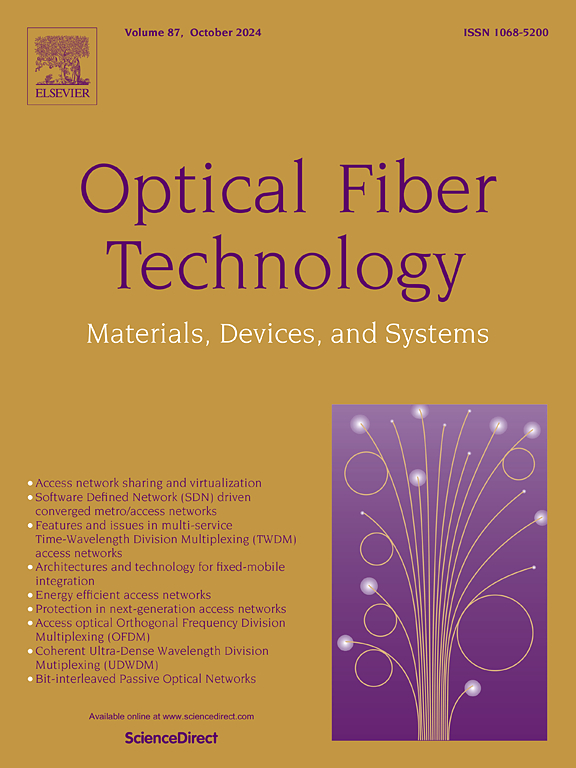Wavelength-tunable erbium-doped fiber laser based on peanut structure and U-bent single-mode fiber coated with CS/PAA for Cu2+ concentration sensing
IF 2.6
3区 计算机科学
Q2 ENGINEERING, ELECTRICAL & ELECTRONIC
引用次数: 0
Abstract
In the paper, a single wavelength-tunable erbium-doped fiber ring laser for copper ions concentration sensing was proposed and demonstrated. The Mach-Zehnder interferometer (MZI), as the frequency-selective component of the laser, comprised a fiber peanut structure (FPS) and a U-bent fiber coated with layer-by-layer self-assembled chitosan (CS) and polyacrylic acid (PAA). The functionalized MZI exhibited a blue-shift of the interference dip with increasing concentration, and the sensitivity was 0.0015 nm/(mg/L). The maximum signal-to-noise ratio (SNR) was only 7.45 dB, hindering the precise localization of sensing signals. By inserting the functionalized MZI into the laser cavity, a single-wavelength laser was achieved; and the laser wavelength shifted from 1532.21 nm to 1529.00 nm as the concentration increased from 100 to 1000 mg/L. Furthermore, the sensitivity was 0.0036 nm/(mg/L), and the maximum SNR was 27.82 dB, significantly higher than that of the MZI sensor for copper ions concentration sensing. The laser wavelength fluctuations measured were less than 0.14 nm and 0.09 nm for the copper ions concentrations of 100 mg/L and 700 mg/L, respectively, over a scan time of 20 min. The laser sensor and U-bent probe structure make it potentially great for application in plating solution tanks and other environments unsuited for sensor deployment.
求助全文
约1分钟内获得全文
求助全文
来源期刊

Optical Fiber Technology
工程技术-电信学
CiteScore
4.80
自引率
11.10%
发文量
327
审稿时长
63 days
期刊介绍:
Innovations in optical fiber technology are revolutionizing world communications. Newly developed fiber amplifiers allow for direct transmission of high-speed signals over transcontinental distances without the need for electronic regeneration. Optical fibers find new applications in data processing. The impact of fiber materials, devices, and systems on communications in the coming decades will create an abundance of primary literature and the need for up-to-date reviews.
Optical Fiber Technology: Materials, Devices, and Systems is a new cutting-edge journal designed to fill a need in this rapidly evolving field for speedy publication of regular length papers. Both theoretical and experimental papers on fiber materials, devices, and system performance evaluation and measurements are eligible, with emphasis on practical applications.
 求助内容:
求助内容: 应助结果提醒方式:
应助结果提醒方式:


